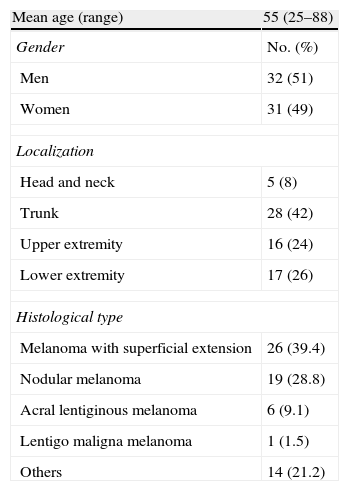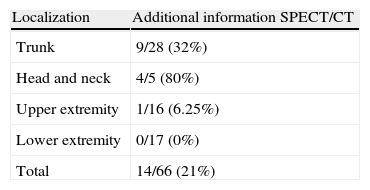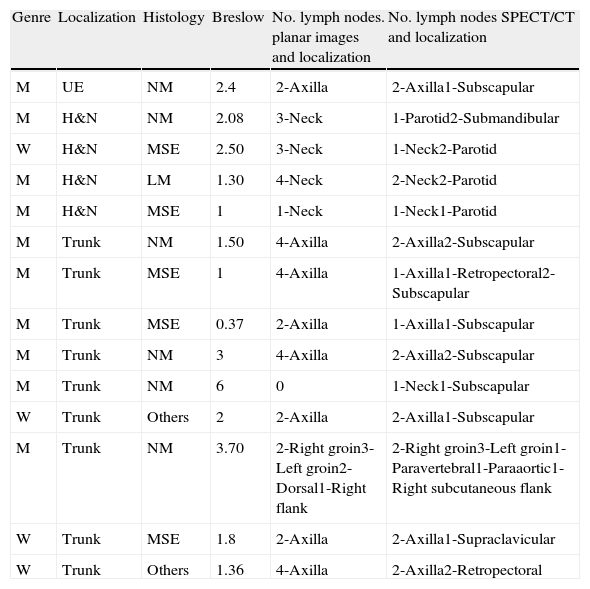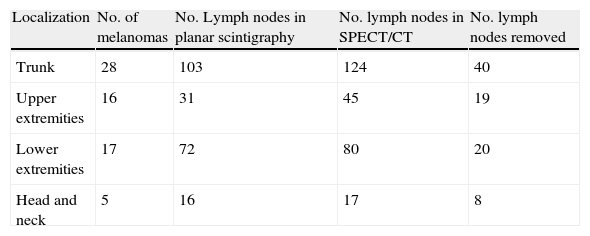To assess the contribution of SPECT–CT lymphoscintigraphy in selective sentinel lymph node biopsy (SLNB) in patients with newly diagnosed malignant melanoma.
Material and methodsA prospective study was made between July 2009 and October 2010. It included 63 patients diagnosed with melanoma (32 men and 31 women) with mean age of 55 years (range: 25–88) and inclusion criteria for SLNB. The melanomas were located as follows: 28 in trunk, 5 in head and neck, 16 in upper limbs and 17 in lower limbs. Three patients had two melanomas. Preoperative lymphoscintigraphy was performed after pericicatricial/perilesional injection of 74MBq of 99mTc-labeled nanocolloid human serum albumin, obtaining early planar images, late whole body study and sectorial images and SPECT–CT in the area of interest. Planar scintigraphy findings were compared with SPECT–CT.
ResultsThe sentinel node (SN) was localized by planar imaging in 62/63 (98%) patients. SPECT–CT study located the SN in all the patients with a detection rate of 100%. The number of SNs detected with SPECT–CT was higher than that with the planar study in 27 patients. The SPECT–CT provided additional information (change in location and/or in its accuracy in the localization of location uncertain SN) in 14/63 (22.2%) patients, involving changes in the surgical approach and lymph node staging.
ConclusionSPECT–CT detects a higher number of SN than planar lymphoscintigraphy in patients with melanoma. Its contribution is more relevant in the melanomas located on the trunk, head and neck. SPECT–CT modified the SN location by 22% compared to planar scan findings, facilitating a correct surgical approach.
Evaluar la aportación de la linfogammagrafía con SPECT-TAC en la biopsia selectiva del ganglio centinela (BSGC) en pacientes con melanoma.
Material y métodosEstudio prospectivo (julio de 2009 a octubre de 2010) incluyendo 63 pacientes diagnosticados de melanoma (32 hombres y 31 mujeres), con edad media de 55 años y criterios de inclusión de BSGC. La localización de los melanomas fue: 28 en el tronco, 5 en la cabeza y el cuello, 16 en los miembros superiores y 17 en los miembros inferiores. Tres pacientes presentaban 2 melanomas. Se realizó linfogammagrafía preoperatoria tras la inyección pericicatricial/perilesional de 74MBq de nanocoloide de albúmina humana marcada con 99mTc, obteniéndose imágenes planares precoces, estudio tardío de cuerpo completo, imágenes sectoriales y SPECT-TAC de la zona de interés. Se compararon los hallazgos de la gammagrafía planar y la SPECT-TAC.
ResultadosEl ganglio centinela (GC) fue localizado mediante las imágenes planares en 62/63 (98%) pacientes. La SPECT-TAC localizó el GC en los 63 pacientes (100%). El número de GC detectados con SPECT-TAC fue superior al estudio planar en 27 pacientes. El estudio SPECT-TAC aportó información adicional (cambio de localización y/o precisión de la misma en GC de ubicación incierta) en 14/63 (22,2%) pacientes, implicando cambios en el abordaje quirúrgico y en la estadificación ganglionar.
ConclusiónLa SPECT-TAC detecta mayor número de GC que la gammagrafía planar, siendo más relevante su aportación en los melanomas de tronco y cabeza y en los de cuello. En un 22% modificó la localización del GC respecto a los hallazgos de la gammagrafía planar, facilitando un correcto abordaje quirúrgico.
Article
If you experience access problems, you can contact the SEMNIM Technical Secretariat by email at secretaria.tecnica@semnim.es or by phone at +34 619 594 780.

Revista Española de Medicina Nuclear e Imagen Molecular (English Edition)













